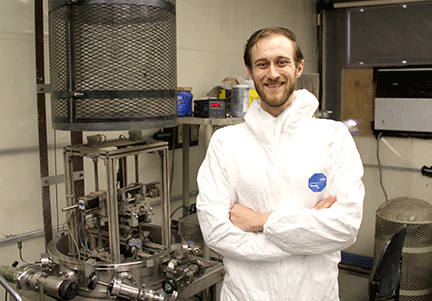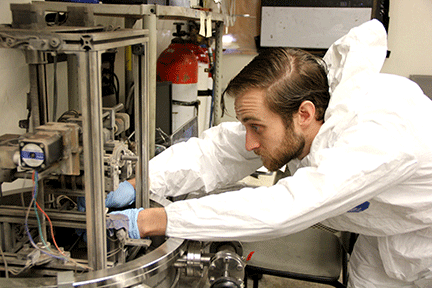NMT Grad Student Lands Prestigious NASA Fellowship For Materials Research
October 23, 2019
Robert Calvo’s project is fully funded via competitive grant
SOCORRO, N.M. – Graduate student Robert Calvo recently was awarded a prestigious NASA Space Technology Research Fellowship to pursue his project in the Materials Engineering Department.
 Calvo, along with his advisor Dr. Paul Fuierer, is developing a novel coating and
application process intended for space structures and ships.
Calvo, along with his advisor Dr. Paul Fuierer, is developing a novel coating and
application process intended for space structures and ships.
“I was very surprised to get this fellowship,” he said. “Just excitement. I was still an undergrad when I submitted my proposal. A program like NASA thought my proposal was worthwhile to invest in – that was overwhelming. I couldn’t believe it.”
The fellowship is for one year, but renewable for three years. The award covers his tuition and fees, a stipend, and travel. Once his testing has reached a sufficient point at NMT, he’ll spend time at NASA Glenn Research Center in Cleveland to continue testing. He’ll also present his research at a NASA Conference.
Calvo’s project involves the application of protective ceramic coatings to space structures made of polymeric materials like Mylar and Kapton, which are subject to damage from atomic oxygen in low-Earth orbit.
 Existing polymers for space structures are subject to erosion due to atomic oxygen,
which makes up much of the atmosphere in low-Earth orbit. Calvo’s novel coating can
be applied at room temperature.
Existing polymers for space structures are subject to erosion due to atomic oxygen,
which makes up much of the atmosphere in low-Earth orbit. Calvo’s novel coating can
be applied at room temperature.
“For the first, time, we can use the dry aerosol deposition process to put nanocrystalline ceramic coatings on low melting-point substrates.,” he said. “With this special process, we can hopefully prevent atomic oxygen erosion of Mylar and Kapton. This will be a new processing methodology for space applications.”
“I need to produce my films and do mechanical and optical testing,” Calvo said. “I need to find the specific parameters to produce the films of exact thickness on these polymeric substrates. I will find the parameters through iterative experiments.”
Once he produces various iterations, he’ll test the films for performance via scanning electron microscope for imaging, scratch testing, and mechanical testing.
 “At Glenn, I’ll take samples to their atomic oxygen beam, where they’ll expose the
films to the conditions of low-Earth orbit,” Calvo said. “We’ll see how much it changes.”
“At Glenn, I’ll take samples to their atomic oxygen beam, where they’ll expose the
films to the conditions of low-Earth orbit,” Calvo said. “We’ll see how much it changes.”
“This process is a jumping-off point,” Calvo said. “This has broader implications. The process lends itself to application in space because it only needs vacuum. It can be preformed in low-earth orbit rather than here on earth. It also can be applied to coatings for a wide variety of other space applications such as thermal, radiation and impact protection..”
As an undergrad, he worked three years in Dr. Fuierer’s aerosol deposition lab. A San Diego native, Calvo earned his bachelor’s at NMT in May 2019.
– NMT –